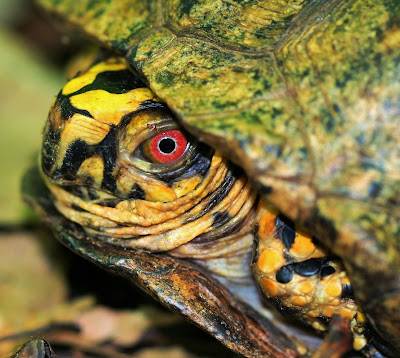REDLAIR NATURE PRESERVE
I had an amazing visit to the Redlair Nature Preserve in
Gastonia, North Carolina. The 775 acre Redlair preserve is part of the larger Spencer
Mountain Conservation Area that consists of approximately 1300 acres (1). The hike was sponsored by the North Carolina Friends
of Plant Conservation and our gracious hosts were Haywood Rankin, the current steward,
whose family once owned the preserve, and Lesley Starke, a plant ecologist with
the N.C. Plant Conservation Program.
Redlair preserve is a mosaic of habitats including pastures,
pine forests, hardwood forests, river bluffs, and ponds. Our hike only gave us
a small but impressive glimpse of this unique preserve. As we entered the
forest I was instantly reminded of the North Carolina mountains. Along the deeply shaded trails I saw evidence
of spring ephemerals such as Mayapple (Podophylum
peltatum), Bloodroot (Sanguinaria canadensis),
Catesby’s Trillium (Trillium catesbaei),
Liverwort (Anemone americana) and Wild
Comfrey (Cynoglossum virginianum). I
also observed many familiar ferns such as Christmas fern (Polystichum acrostichoides), Rattlesnake fern (Botrychium virginianum), and Broad Beech Fern (Phegopteris hexagonoptera). Another reason I was reminded of the
mountains was the terrain. During our three hour tour we hiked over rolling
hills, along ridges, and transversed deep ravines often cut by small streams. With
all the up and down I was surprised to learn that the total elevation relief is
only 200 feet.
 |
| Round-leaf Liverwort- Anemone americana (Hepatica americana) |
 |
| Mayapple (Podophyllum peltatum) Fruit |
 |
| Bigleaf Magnolia - Magnolia macrophylla |
Seeing the canopy filled with these gigantic leaves was a majestic and surreal sight. The large leafs may be why the trees seem to prefer the deep mesic ravines found in the preserve. The ravines protect the trees from wind that can easily damage their large leaves.
 |
| Look carefully and you will see a Luna Moth resting on the underside of a Bigleaf Magnolia leaf. |
 |
| After crossing one of many small creeks we spotted a beautiful Northern Watersnake ( Nerodia sipedon). |
The second species emphasized by our guide was the federally endangered Helianthus schweinitzii, or Schweinitz's
Sunflower. It is the rarest sunflower species in the United States (4). This plant is found in disturbed
habitats, such as roadsides and power lines, in the piedmont regions of North
and South Carolina.
 |
| Helianthus schweinitzii, or Schweinitz's Sunflower Photo by Trena McNabb, from the North Carolina Native Plant Society Webpage |
It is thought to be a residual plant from the native Piedmont
prairies that once covered large areas of the Carolinas. The plant has several unique characteristics including
edible tubers, a potential height of 15 feet, purplish-red stems, and long
stiff leaves. Unfortunately, we were too early in the season to see the plants in
bloom but I volunteered to help with a population survey later in the fall.
Other species, in bloom, that we spotted along our hike include
Variegated Milkweed (Asclepias varigata),
Pinesap (Monotropa hypopithys), Black
Cohosh (Actaea racemose), Eastern Smooth
Beardtongue (Penstemon laevigatus), and
Pasture Rose (Rosa carolina). I was
also very excited to see Chalk Maple (Acer
leucoderme).
 |
| Eastern Smooth Beardtongue (Penstemon laevigatus) |
 |
| Variegated Milkweed (Asclepias varigata) |
 |
| Pasture Rose (Rosa carolina) |
 |
| Chalk Maple (Acer leucoderme) |
 |
| Eastern Box Turtle (Terrapene carolina) |
I am looking forward to my return trip in the fall to see Schweinitz's
Sunflower in bloom and to see what other treasures the preserve holds and protects!
Note: Unless otherwise noted all photographs were taken by
the author.
Resources:
1. Redlair Preserve -- Discover Life. N.p., n.d. Web. 27 May
2017.
2. "André Michaux International Symposium." Am Ecological
Study of MAGNOLIA MACROPHYLLA (BigLeaf Magnolia) in Gaston County, North
Carolina. N.p., n.d. Web. 27 May 2017.
3. Radford, Albert Ernest, Harry E. Ahles, and Clyde Ritchie
Bell. Manual of the Vascular Flora of the
Carolinas. Chapel Hill, NC: U of North Carolina Press, 1983.
4. Schweinitz's
Sunflower, Helianthus schweinitzii: Hilton Pond Research. N.p., n.d. Web.
27 May 2017.

No comments:
Post a Comment
Note: Only a member of this blog may post a comment.